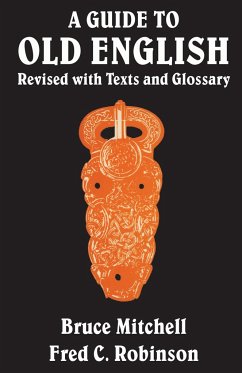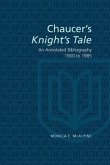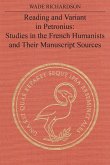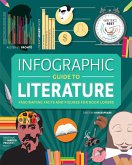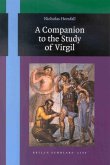- Broschiertes Buch
- Merkliste
- Auf die Merkliste
- Bewerten Bewerten
- Teilen
- Produkt teilen
- Produkterinnerung
- Produkterinnerung
A Guide to Old English has established itself as the most thorough and most stimulating introduction to the language of Anglo-Saxon England. This revised edition adds ten basic texts, together with full notes and a comprehensive glossary, which convert the Guide into a self-contained course book for students beginning a study of Old English.
Andere Kunden interessierten sich auch für
![Chaucer's Knight's Tale Chaucer's Knight's Tale]() Monica McAlpineChaucer's Knight's Tale65,99 €
Monica McAlpineChaucer's Knight's Tale65,99 €![Reading and Variant in Petronius Reading and Variant in Petronius]() Wade T RichardsonReading and Variant in Petronius55,99 €
Wade T RichardsonReading and Variant in Petronius55,99 €![Come Again?: Racy Slang, Expletives, and Curses from Around the World Come Again?: Racy Slang, Expletives, and Curses from Around the World]() Jeremy R. EllisCome Again?: Racy Slang, Expletives, and Curses from Around the World13,99 €
Jeremy R. EllisCome Again?: Racy Slang, Expletives, and Curses from Around the World13,99 €![Infographic Guide to Literature Infographic Guide to Literature]() Joanna EliotInfographic Guide to Literature18,99 €
Joanna EliotInfographic Guide to Literature18,99 €![A Companion to the Study of Virgil A Companion to the Study of Virgil]() Nicholas HorsfallA Companion to the Study of Virgil93,99 €
Nicholas HorsfallA Companion to the Study of Virgil93,99 €![promptus - Würzburger Beiträge zur Romanistik promptus - Würzburger Beiträge zur Romanistik]() promptus - Würzburger Beiträge zur Romanistik29,99 €
promptus - Würzburger Beiträge zur Romanistik29,99 €![The Novel in the Ancient World The Novel in the Ancient World]() The Novel in the Ancient World104,99 €
The Novel in the Ancient World104,99 €-
-
-
A Guide to Old English has established itself as the most thorough and most stimulating introduction to the language of Anglo-Saxon England. This revised edition adds ten basic texts, together with full notes and a comprehensive glossary, which convert the Guide into a self-contained course book for students beginning a study of Old English.
Hinweis: Dieser Artikel kann nur an eine deutsche Lieferadresse ausgeliefert werden.
Hinweis: Dieser Artikel kann nur an eine deutsche Lieferadresse ausgeliefert werden.
Produktdetails
- Produktdetails
- Verlag: University of Toronto Press
- Seitenzahl: 271
- Erscheinungstermin: 15. Dezember 1982
- Englisch
- Abmessung: 211mm x 135mm x 21mm
- Gewicht: 342g
- ISBN-13: 9780802065131
- ISBN-10: 0802065139
- Artikelnr.: 53301923
- Herstellerkennzeichnung
- Libri GmbH
- Europaallee 1
- 36244 Bad Hersfeld
- gpsr@libri.de
- Verlag: University of Toronto Press
- Seitenzahl: 271
- Erscheinungstermin: 15. Dezember 1982
- Englisch
- Abmessung: 211mm x 135mm x 21mm
- Gewicht: 342g
- ISBN-13: 9780802065131
- ISBN-10: 0802065139
- Artikelnr.: 53301923
- Herstellerkennzeichnung
- Libri GmbH
- Europaallee 1
- 36244 Bad Hersfeld
- gpsr@libri.de
BRUCE MITCHELL was University Lecturer in English and Fellow of St Edmund Hall, University of Oxford.
Foreword to the Eighth Edition vi
Map of Anglo-Saxon England vii
Abbreviations and Symbols xv
How to Use this Guide 1
PART ONE.
1 Preliminary Remarks on the Language (§§1-4) 11
2 Orthography and Pronunciation (§§5-9) 13
i Orthography (§5) 13
ii Stress (§6) 13
iii Vowels (§7) 14
iv Diphthongs (§8) 14
v Consonants (§9) 15
3 Inflexions (§§10-135) 17
Introduction (§§10-14) 17
i Pronouns (§§15-21) 18
ii Nouns and Sound-Changes Relevant to Them (§§22-62) 20
Weak Nouns (§§22-25) 20
Some Technical Terms (§§26-32) 20
Strong Nouns like stan (masc.) and scip (neut.) (§§33-44) 22
Masculine and Neuter Nouns in -e (§§45-46) 26
Strong Feminine Nouns (§§47-51) 27
i-Mutation (§§52-57) 28
Nouns Affected by i-Mutation (§§58-60) 29
u-Nouns (§§61-62) 30
iii Adjectives (§§63-76) 31
Introduction (§§63-64) 31
Weak Declension (§65) 31
Strong Declension (§§66-67) 31
Stem Changes in Adjectives (§§68-73) 32
Comparison of Adjectives (§§74-76) 33
iv Observations on Noun, Adjective, and Pronoun
Declensions (§§77-81) 34
v Numerals (§§82-86) 34
vi Strong Verbs and Sound-Changes Relevant to
Them (§§87-114) 35
Introduction (§§87-89) 35
Principal Parts of the Strong Verbs (§§90-95) 36
Breaking (§§96-99) 38
Influence of Initial i, sc, h (§100) 39
Influence of Nasals (§101) 40
Summary of the Strong Verbs of Class III (§102) 40
The Effects of Sound-Changes on Other Strong Verbs (§103) 40
Strong Verbs of Class VII (§104) 41
Grimm's Law and Verner's Law (§§105-109) 41
Conjugation of the Strong Verb (§§110-114) 43
vii Weak Verbs and Sound-Changes Relevant to
Them (§§115-126) 46
Introduction (§115) 46
Class 1 (§§116-123) 46
Class 2 (§§124-125) 49
Class 3 (§126) 50
viii Anomalous Verbs (§§127-130) 51
Bbon (§127) 51
Ddn and gan (§128) 51
Willan (§129) 52
Preterite-Present Verbs (§130) 52
ix Is a Verb Strong or Weak? To which Class does it Belong? (§§131-134) 53
x Adverbs (§135) 54
Formation (§135) 54
Comparison (§135) 54
4 Word Formation (§§136-138) 55
Introduction (§136) 55
i Compounding (§137) 56
ii The Addition of Affixes (§138) 57
Prefixes (§138) 58
Suffixes (§138) 59
5 Syntax (§§139-214) 61
Introduction (§§139-142) 61
i Word-Order (§§143-147) 63
ii Sentence Structure (§§148-153) 66
Recapitulation and Anticipation (§148) 66
The Splitting of Heavy Groups (§149) 67
Correlation (§§150-153) 68
iii Noun Clauses (§§154-161) 70
Introduction (§154) 70
Dependent Statements and Desires (§§155-156) 70
Dependent Questions (§§157-160) 72
The Accusative and Infinitive (§161) 75
iv Adjective Clauses (§§162-165) 75
Definite Adjective Clauses (§§162-163) 75
Indefinite Adjective Clauses (§164) 79
Mood (§165) 80
v Adverb Clauses (§§166-181) 81
Introduction (§§166-167) 81
Non-Prepositional Conjunctions (§168) 83
Prepositional Conjunctions (§§169-171) 83
An Exercise in Analysis (§172) 86
Clauses of Place (§173) 87
Clauses of Time (§174) 88
Clauses of Purpose and Result (§175) 89
Causal Clauses (§176) 89
Clauses of Comparison (§177) 89
Clauses of Concession (§178) 90
Clauses of Condition (§179) 91
Adverb Clauses Expressing Other Relationships (§180) 92
Other Ways of Expressing Adverbial Relationships (§181) 93
vi Parataxis (§§182-186) 93
Introduction (§§182-183) 93
List of Conjunctions and Adverbs Commonly
Used (§184) 94
Parataxis without Conjunctions (§185) 96
Some Special Idioms (§186) 96
vii Concord (§187) 97
1. Nouns, Pronouns and their Modifiers (§187) 97
2. Pronouns and their Antecedents (§187) 97
3. Subject and Verb (§187) 98
viii The Uses of the Cases (§§188-192) 98
Nominative (§188) 98
Accusative (§189) 99
Genitive (§190) 99
Dative (§191) 99
Instrumental (§192) 100
ix Articles, Pronouns, and Numerals (§§193-194) 100
Articles and Pronouns (§193) 100
Numerals (§194) 101
x Verbs (§§195-212) 101
The Uses of the Present and Preterite Tenses (§§195-198) 101
The Resolved Tenses (§§199-204) 103
Introduction (§199) 103
The Verb 'to have' as an Auxiliary (§200) 103
The Verb 'to be' as an Auxiliary of Tense (§201) 104
The Passive (§§202-203) 104
Other Uses of the Present and Past Participles (§204) 105
The Uses of the Infinitives (§205) 105
The 'Modal' Auxiliaries (§§206-211) 106
Introduction (§206) 106
Magan (§207) 107
*Mdtan (§208) 107
Cunnan (§209) 108
*Sculan (§210) 108
Willan (§211) 108
Impersonal Verbs (§212) 109
xi Prepositions (§§213-214) 109
List of Prepositions (§214) 110
6 An Introduction to Anglo-Saxon Studies (§§215-251) 111
i Some Significant Dates (§§215-216) 111
ii History (§§217-218) 111
iii Archaeology (§§219-230) 117
Introduction (§219) 117
List of Abbreviated Titles (§220) 118
Weapons and Warfare (§221) 120
Life and Dress (§222) 120
Architecture and Buildings (§§223-224) 121
Sculpture and Carving (§225) 122
Jewellery and Metalwork (§226) 123
Embroidery (§227) 123
Coins (§228) 124
Manuscripts and Runic Inscriptions (§229) 124
The Sutton Hoo Ship-Burial (§230) 124
iv Language (§§231-235) 125
Changes in English (§231) 125
The Danish Invasions (§232) 126
The Norman Conquest (§233) 127
Vocabulary (§234) 127
Some Questions (§235) 128
v Literature (§§236-251) 128
Introduction (§§236-246) 128
Poetry (§§247-249) 134
Prose (§§250-251) 135
7 Select Bibliography (§§252-269) 137
General (§252) 137
Chapter 1 Preliminary Remarks on the Language (§253) 137
Chapter 2 Orthography and Pronunciation (§254) 138
Chapter 3 Inflexions (§254) 138
Chapter 4 Word Formation (§255) 138
Chapter 5 Syntax (§256) 138
Chapter 6 Introduction to Anglo-Saxon Studies (§§257-269) 139
History (§257) 139
Archaeology (§258) 139
Language (§§259-261) 140
History of English Prose (§259) 140
Vocabulary (§§260-261) 140
Word Formation 140
Changes of Meaning (§260) 140
Borrowings (§261) 140
Literature (§§262-269) 141
Topics Raised in §§236-246 (§262) 141
General Criticism (§263) 141
Poetry Texts (§264) 141
Appreciation of the Poetry (§265) 143
The Use of Oral Formulae (§266) 143
Metre (§267) 143
Prose Texts (§268) 144
Sources (§269) 144
Appendix A Strong Verbs 146
Appendix B Some Effects of i-Mutation 154
Appendix C Metre 156
Appendix D List of Linguistic Terms Used in this Book 163
Appendix E The Moods of Old English 174
Appendix F Grimm's and Verner's Laws 175
PART TWO: PROSE AND VERSE TEXTS.
1 Practice Sentences 179
2 Two Old Testament Pieces 181
The Fall of Man 182
Abraham and Isaac 186
3 A Colloquy on the Occupations 190
4 Two Characteristic Prose Works by Ælfric 198
Preface to Genesis 198
St. Edmund, King and Martyr 203
5 Alfred the Great's Preface to his Translation of Gregory's Pastoral Care
212
6 Cynewulf and Cyneheard 216
7 Selections from the Anglo-Saxon Chronicle 220
8 Bede's Account of the Conversion of King Edwin 224
9 Bede's Account of the Poet Cædmon 228
10 The Goths and Boethius: Prose and Verse from the Introduction to King
Alfred's Boethius Translation 234
11 (a)-(p) Riddles 239
12 The Battle of Maldon 249
13 The Ruin 261
14 The Dream of the Rood 264
15 The Wife's Lament 272
16 The Wanderer 276
17 The Seafarer 284
18 Four excerpts from Beowulf 291
Prologue 294
(a) Beowulf's Fight with Grendel 296
(b) Beowulf Consoles Hrothgar for Æschere's Death 303
(c) The Lament of the Last Survivor 306
(d) Beowulf's Funeral 307
19 Wulf and Eadwacer 309
20 Judith 312
21 Cotton Gnomes or Maxims 325
22 Sermo Lupi ad Anglos 329
Glossary 337
Indexes to Part One 418
Index of Subjects 418
Index of Words 422
Map of Anglo-Saxon England vii
Abbreviations and Symbols xv
How to Use this Guide 1
PART ONE.
1 Preliminary Remarks on the Language (§§1-4) 11
2 Orthography and Pronunciation (§§5-9) 13
i Orthography (§5) 13
ii Stress (§6) 13
iii Vowels (§7) 14
iv Diphthongs (§8) 14
v Consonants (§9) 15
3 Inflexions (§§10-135) 17
Introduction (§§10-14) 17
i Pronouns (§§15-21) 18
ii Nouns and Sound-Changes Relevant to Them (§§22-62) 20
Weak Nouns (§§22-25) 20
Some Technical Terms (§§26-32) 20
Strong Nouns like stan (masc.) and scip (neut.) (§§33-44) 22
Masculine and Neuter Nouns in -e (§§45-46) 26
Strong Feminine Nouns (§§47-51) 27
i-Mutation (§§52-57) 28
Nouns Affected by i-Mutation (§§58-60) 29
u-Nouns (§§61-62) 30
iii Adjectives (§§63-76) 31
Introduction (§§63-64) 31
Weak Declension (§65) 31
Strong Declension (§§66-67) 31
Stem Changes in Adjectives (§§68-73) 32
Comparison of Adjectives (§§74-76) 33
iv Observations on Noun, Adjective, and Pronoun
Declensions (§§77-81) 34
v Numerals (§§82-86) 34
vi Strong Verbs and Sound-Changes Relevant to
Them (§§87-114) 35
Introduction (§§87-89) 35
Principal Parts of the Strong Verbs (§§90-95) 36
Breaking (§§96-99) 38
Influence of Initial i, sc, h (§100) 39
Influence of Nasals (§101) 40
Summary of the Strong Verbs of Class III (§102) 40
The Effects of Sound-Changes on Other Strong Verbs (§103) 40
Strong Verbs of Class VII (§104) 41
Grimm's Law and Verner's Law (§§105-109) 41
Conjugation of the Strong Verb (§§110-114) 43
vii Weak Verbs and Sound-Changes Relevant to
Them (§§115-126) 46
Introduction (§115) 46
Class 1 (§§116-123) 46
Class 2 (§§124-125) 49
Class 3 (§126) 50
viii Anomalous Verbs (§§127-130) 51
Bbon (§127) 51
Ddn and gan (§128) 51
Willan (§129) 52
Preterite-Present Verbs (§130) 52
ix Is a Verb Strong or Weak? To which Class does it Belong? (§§131-134) 53
x Adverbs (§135) 54
Formation (§135) 54
Comparison (§135) 54
4 Word Formation (§§136-138) 55
Introduction (§136) 55
i Compounding (§137) 56
ii The Addition of Affixes (§138) 57
Prefixes (§138) 58
Suffixes (§138) 59
5 Syntax (§§139-214) 61
Introduction (§§139-142) 61
i Word-Order (§§143-147) 63
ii Sentence Structure (§§148-153) 66
Recapitulation and Anticipation (§148) 66
The Splitting of Heavy Groups (§149) 67
Correlation (§§150-153) 68
iii Noun Clauses (§§154-161) 70
Introduction (§154) 70
Dependent Statements and Desires (§§155-156) 70
Dependent Questions (§§157-160) 72
The Accusative and Infinitive (§161) 75
iv Adjective Clauses (§§162-165) 75
Definite Adjective Clauses (§§162-163) 75
Indefinite Adjective Clauses (§164) 79
Mood (§165) 80
v Adverb Clauses (§§166-181) 81
Introduction (§§166-167) 81
Non-Prepositional Conjunctions (§168) 83
Prepositional Conjunctions (§§169-171) 83
An Exercise in Analysis (§172) 86
Clauses of Place (§173) 87
Clauses of Time (§174) 88
Clauses of Purpose and Result (§175) 89
Causal Clauses (§176) 89
Clauses of Comparison (§177) 89
Clauses of Concession (§178) 90
Clauses of Condition (§179) 91
Adverb Clauses Expressing Other Relationships (§180) 92
Other Ways of Expressing Adverbial Relationships (§181) 93
vi Parataxis (§§182-186) 93
Introduction (§§182-183) 93
List of Conjunctions and Adverbs Commonly
Used (§184) 94
Parataxis without Conjunctions (§185) 96
Some Special Idioms (§186) 96
vii Concord (§187) 97
1. Nouns, Pronouns and their Modifiers (§187) 97
2. Pronouns and their Antecedents (§187) 97
3. Subject and Verb (§187) 98
viii The Uses of the Cases (§§188-192) 98
Nominative (§188) 98
Accusative (§189) 99
Genitive (§190) 99
Dative (§191) 99
Instrumental (§192) 100
ix Articles, Pronouns, and Numerals (§§193-194) 100
Articles and Pronouns (§193) 100
Numerals (§194) 101
x Verbs (§§195-212) 101
The Uses of the Present and Preterite Tenses (§§195-198) 101
The Resolved Tenses (§§199-204) 103
Introduction (§199) 103
The Verb 'to have' as an Auxiliary (§200) 103
The Verb 'to be' as an Auxiliary of Tense (§201) 104
The Passive (§§202-203) 104
Other Uses of the Present and Past Participles (§204) 105
The Uses of the Infinitives (§205) 105
The 'Modal' Auxiliaries (§§206-211) 106
Introduction (§206) 106
Magan (§207) 107
*Mdtan (§208) 107
Cunnan (§209) 108
*Sculan (§210) 108
Willan (§211) 108
Impersonal Verbs (§212) 109
xi Prepositions (§§213-214) 109
List of Prepositions (§214) 110
6 An Introduction to Anglo-Saxon Studies (§§215-251) 111
i Some Significant Dates (§§215-216) 111
ii History (§§217-218) 111
iii Archaeology (§§219-230) 117
Introduction (§219) 117
List of Abbreviated Titles (§220) 118
Weapons and Warfare (§221) 120
Life and Dress (§222) 120
Architecture and Buildings (§§223-224) 121
Sculpture and Carving (§225) 122
Jewellery and Metalwork (§226) 123
Embroidery (§227) 123
Coins (§228) 124
Manuscripts and Runic Inscriptions (§229) 124
The Sutton Hoo Ship-Burial (§230) 124
iv Language (§§231-235) 125
Changes in English (§231) 125
The Danish Invasions (§232) 126
The Norman Conquest (§233) 127
Vocabulary (§234) 127
Some Questions (§235) 128
v Literature (§§236-251) 128
Introduction (§§236-246) 128
Poetry (§§247-249) 134
Prose (§§250-251) 135
7 Select Bibliography (§§252-269) 137
General (§252) 137
Chapter 1 Preliminary Remarks on the Language (§253) 137
Chapter 2 Orthography and Pronunciation (§254) 138
Chapter 3 Inflexions (§254) 138
Chapter 4 Word Formation (§255) 138
Chapter 5 Syntax (§256) 138
Chapter 6 Introduction to Anglo-Saxon Studies (§§257-269) 139
History (§257) 139
Archaeology (§258) 139
Language (§§259-261) 140
History of English Prose (§259) 140
Vocabulary (§§260-261) 140
Word Formation 140
Changes of Meaning (§260) 140
Borrowings (§261) 140
Literature (§§262-269) 141
Topics Raised in §§236-246 (§262) 141
General Criticism (§263) 141
Poetry Texts (§264) 141
Appreciation of the Poetry (§265) 143
The Use of Oral Formulae (§266) 143
Metre (§267) 143
Prose Texts (§268) 144
Sources (§269) 144
Appendix A Strong Verbs 146
Appendix B Some Effects of i-Mutation 154
Appendix C Metre 156
Appendix D List of Linguistic Terms Used in this Book 163
Appendix E The Moods of Old English 174
Appendix F Grimm's and Verner's Laws 175
PART TWO: PROSE AND VERSE TEXTS.
1 Practice Sentences 179
2 Two Old Testament Pieces 181
The Fall of Man 182
Abraham and Isaac 186
3 A Colloquy on the Occupations 190
4 Two Characteristic Prose Works by Ælfric 198
Preface to Genesis 198
St. Edmund, King and Martyr 203
5 Alfred the Great's Preface to his Translation of Gregory's Pastoral Care
212
6 Cynewulf and Cyneheard 216
7 Selections from the Anglo-Saxon Chronicle 220
8 Bede's Account of the Conversion of King Edwin 224
9 Bede's Account of the Poet Cædmon 228
10 The Goths and Boethius: Prose and Verse from the Introduction to King
Alfred's Boethius Translation 234
11 (a)-(p) Riddles 239
12 The Battle of Maldon 249
13 The Ruin 261
14 The Dream of the Rood 264
15 The Wife's Lament 272
16 The Wanderer 276
17 The Seafarer 284
18 Four excerpts from Beowulf 291
Prologue 294
(a) Beowulf's Fight with Grendel 296
(b) Beowulf Consoles Hrothgar for Æschere's Death 303
(c) The Lament of the Last Survivor 306
(d) Beowulf's Funeral 307
19 Wulf and Eadwacer 309
20 Judith 312
21 Cotton Gnomes or Maxims 325
22 Sermo Lupi ad Anglos 329
Glossary 337
Indexes to Part One 418
Index of Subjects 418
Index of Words 422
Foreword to the Eighth Edition vi
Map of Anglo-Saxon England vii
Abbreviations and Symbols xv
How to Use this Guide 1
PART ONE.
1 Preliminary Remarks on the Language (§§1-4) 11
2 Orthography and Pronunciation (§§5-9) 13
i Orthography (§5) 13
ii Stress (§6) 13
iii Vowels (§7) 14
iv Diphthongs (§8) 14
v Consonants (§9) 15
3 Inflexions (§§10-135) 17
Introduction (§§10-14) 17
i Pronouns (§§15-21) 18
ii Nouns and Sound-Changes Relevant to Them (§§22-62) 20
Weak Nouns (§§22-25) 20
Some Technical Terms (§§26-32) 20
Strong Nouns like stan (masc.) and scip (neut.) (§§33-44) 22
Masculine and Neuter Nouns in -e (§§45-46) 26
Strong Feminine Nouns (§§47-51) 27
i-Mutation (§§52-57) 28
Nouns Affected by i-Mutation (§§58-60) 29
u-Nouns (§§61-62) 30
iii Adjectives (§§63-76) 31
Introduction (§§63-64) 31
Weak Declension (§65) 31
Strong Declension (§§66-67) 31
Stem Changes in Adjectives (§§68-73) 32
Comparison of Adjectives (§§74-76) 33
iv Observations on Noun, Adjective, and Pronoun
Declensions (§§77-81) 34
v Numerals (§§82-86) 34
vi Strong Verbs and Sound-Changes Relevant to
Them (§§87-114) 35
Introduction (§§87-89) 35
Principal Parts of the Strong Verbs (§§90-95) 36
Breaking (§§96-99) 38
Influence of Initial i, sc, h (§100) 39
Influence of Nasals (§101) 40
Summary of the Strong Verbs of Class III (§102) 40
The Effects of Sound-Changes on Other Strong Verbs (§103) 40
Strong Verbs of Class VII (§104) 41
Grimm's Law and Verner's Law (§§105-109) 41
Conjugation of the Strong Verb (§§110-114) 43
vii Weak Verbs and Sound-Changes Relevant to
Them (§§115-126) 46
Introduction (§115) 46
Class 1 (§§116-123) 46
Class 2 (§§124-125) 49
Class 3 (§126) 50
viii Anomalous Verbs (§§127-130) 51
Bbon (§127) 51
Ddn and gan (§128) 51
Willan (§129) 52
Preterite-Present Verbs (§130) 52
ix Is a Verb Strong or Weak? To which Class does it Belong? (§§131-134) 53
x Adverbs (§135) 54
Formation (§135) 54
Comparison (§135) 54
4 Word Formation (§§136-138) 55
Introduction (§136) 55
i Compounding (§137) 56
ii The Addition of Affixes (§138) 57
Prefixes (§138) 58
Suffixes (§138) 59
5 Syntax (§§139-214) 61
Introduction (§§139-142) 61
i Word-Order (§§143-147) 63
ii Sentence Structure (§§148-153) 66
Recapitulation and Anticipation (§148) 66
The Splitting of Heavy Groups (§149) 67
Correlation (§§150-153) 68
iii Noun Clauses (§§154-161) 70
Introduction (§154) 70
Dependent Statements and Desires (§§155-156) 70
Dependent Questions (§§157-160) 72
The Accusative and Infinitive (§161) 75
iv Adjective Clauses (§§162-165) 75
Definite Adjective Clauses (§§162-163) 75
Indefinite Adjective Clauses (§164) 79
Mood (§165) 80
v Adverb Clauses (§§166-181) 81
Introduction (§§166-167) 81
Non-Prepositional Conjunctions (§168) 83
Prepositional Conjunctions (§§169-171) 83
An Exercise in Analysis (§172) 86
Clauses of Place (§173) 87
Clauses of Time (§174) 88
Clauses of Purpose and Result (§175) 89
Causal Clauses (§176) 89
Clauses of Comparison (§177) 89
Clauses of Concession (§178) 90
Clauses of Condition (§179) 91
Adverb Clauses Expressing Other Relationships (§180) 92
Other Ways of Expressing Adverbial Relationships (§181) 93
vi Parataxis (§§182-186) 93
Introduction (§§182-183) 93
List of Conjunctions and Adverbs Commonly
Used (§184) 94
Parataxis without Conjunctions (§185) 96
Some Special Idioms (§186) 96
vii Concord (§187) 97
1. Nouns, Pronouns and their Modifiers (§187) 97
2. Pronouns and their Antecedents (§187) 97
3. Subject and Verb (§187) 98
viii The Uses of the Cases (§§188-192) 98
Nominative (§188) 98
Accusative (§189) 99
Genitive (§190) 99
Dative (§191) 99
Instrumental (§192) 100
ix Articles, Pronouns, and Numerals (§§193-194) 100
Articles and Pronouns (§193) 100
Numerals (§194) 101
x Verbs (§§195-212) 101
The Uses of the Present and Preterite Tenses (§§195-198) 101
The Resolved Tenses (§§199-204) 103
Introduction (§199) 103
The Verb 'to have' as an Auxiliary (§200) 103
The Verb 'to be' as an Auxiliary of Tense (§201) 104
The Passive (§§202-203) 104
Other Uses of the Present and Past Participles (§204) 105
The Uses of the Infinitives (§205) 105
The 'Modal' Auxiliaries (§§206-211) 106
Introduction (§206) 106
Magan (§207) 107
*Mdtan (§208) 107
Cunnan (§209) 108
*Sculan (§210) 108
Willan (§211) 108
Impersonal Verbs (§212) 109
xi Prepositions (§§213-214) 109
List of Prepositions (§214) 110
6 An Introduction to Anglo-Saxon Studies (§§215-251) 111
i Some Significant Dates (§§215-216) 111
ii History (§§217-218) 111
iii Archaeology (§§219-230) 117
Introduction (§219) 117
List of Abbreviated Titles (§220) 118
Weapons and Warfare (§221) 120
Life and Dress (§222) 120
Architecture and Buildings (§§223-224) 121
Sculpture and Carving (§225) 122
Jewellery and Metalwork (§226) 123
Embroidery (§227) 123
Coins (§228) 124
Manuscripts and Runic Inscriptions (§229) 124
The Sutton Hoo Ship-Burial (§230) 124
iv Language (§§231-235) 125
Changes in English (§231) 125
The Danish Invasions (§232) 126
The Norman Conquest (§233) 127
Vocabulary (§234) 127
Some Questions (§235) 128
v Literature (§§236-251) 128
Introduction (§§236-246) 128
Poetry (§§247-249) 134
Prose (§§250-251) 135
7 Select Bibliography (§§252-269) 137
General (§252) 137
Chapter 1 Preliminary Remarks on the Language (§253) 137
Chapter 2 Orthography and Pronunciation (§254) 138
Chapter 3 Inflexions (§254) 138
Chapter 4 Word Formation (§255) 138
Chapter 5 Syntax (§256) 138
Chapter 6 Introduction to Anglo-Saxon Studies (§§257-269) 139
History (§257) 139
Archaeology (§258) 139
Language (§§259-261) 140
History of English Prose (§259) 140
Vocabulary (§§260-261) 140
Word Formation 140
Changes of Meaning (§260) 140
Borrowings (§261) 140
Literature (§§262-269) 141
Topics Raised in §§236-246 (§262) 141
General Criticism (§263) 141
Poetry Texts (§264) 141
Appreciation of the Poetry (§265) 143
The Use of Oral Formulae (§266) 143
Metre (§267) 143
Prose Texts (§268) 144
Sources (§269) 144
Appendix A Strong Verbs 146
Appendix B Some Effects of i-Mutation 154
Appendix C Metre 156
Appendix D List of Linguistic Terms Used in this Book 163
Appendix E The Moods of Old English 174
Appendix F Grimm's and Verner's Laws 175
PART TWO: PROSE AND VERSE TEXTS.
1 Practice Sentences 179
2 Two Old Testament Pieces 181
The Fall of Man 182
Abraham and Isaac 186
3 A Colloquy on the Occupations 190
4 Two Characteristic Prose Works by Ælfric 198
Preface to Genesis 198
St. Edmund, King and Martyr 203
5 Alfred the Great's Preface to his Translation of Gregory's Pastoral Care
212
6 Cynewulf and Cyneheard 216
7 Selections from the Anglo-Saxon Chronicle 220
8 Bede's Account of the Conversion of King Edwin 224
9 Bede's Account of the Poet Cædmon 228
10 The Goths and Boethius: Prose and Verse from the Introduction to King
Alfred's Boethius Translation 234
11 (a)-(p) Riddles 239
12 The Battle of Maldon 249
13 The Ruin 261
14 The Dream of the Rood 264
15 The Wife's Lament 272
16 The Wanderer 276
17 The Seafarer 284
18 Four excerpts from Beowulf 291
Prologue 294
(a) Beowulf's Fight with Grendel 296
(b) Beowulf Consoles Hrothgar for Æschere's Death 303
(c) The Lament of the Last Survivor 306
(d) Beowulf's Funeral 307
19 Wulf and Eadwacer 309
20 Judith 312
21 Cotton Gnomes or Maxims 325
22 Sermo Lupi ad Anglos 329
Glossary 337
Indexes to Part One 418
Index of Subjects 418
Index of Words 422
Map of Anglo-Saxon England vii
Abbreviations and Symbols xv
How to Use this Guide 1
PART ONE.
1 Preliminary Remarks on the Language (§§1-4) 11
2 Orthography and Pronunciation (§§5-9) 13
i Orthography (§5) 13
ii Stress (§6) 13
iii Vowels (§7) 14
iv Diphthongs (§8) 14
v Consonants (§9) 15
3 Inflexions (§§10-135) 17
Introduction (§§10-14) 17
i Pronouns (§§15-21) 18
ii Nouns and Sound-Changes Relevant to Them (§§22-62) 20
Weak Nouns (§§22-25) 20
Some Technical Terms (§§26-32) 20
Strong Nouns like stan (masc.) and scip (neut.) (§§33-44) 22
Masculine and Neuter Nouns in -e (§§45-46) 26
Strong Feminine Nouns (§§47-51) 27
i-Mutation (§§52-57) 28
Nouns Affected by i-Mutation (§§58-60) 29
u-Nouns (§§61-62) 30
iii Adjectives (§§63-76) 31
Introduction (§§63-64) 31
Weak Declension (§65) 31
Strong Declension (§§66-67) 31
Stem Changes in Adjectives (§§68-73) 32
Comparison of Adjectives (§§74-76) 33
iv Observations on Noun, Adjective, and Pronoun
Declensions (§§77-81) 34
v Numerals (§§82-86) 34
vi Strong Verbs and Sound-Changes Relevant to
Them (§§87-114) 35
Introduction (§§87-89) 35
Principal Parts of the Strong Verbs (§§90-95) 36
Breaking (§§96-99) 38
Influence of Initial i, sc, h (§100) 39
Influence of Nasals (§101) 40
Summary of the Strong Verbs of Class III (§102) 40
The Effects of Sound-Changes on Other Strong Verbs (§103) 40
Strong Verbs of Class VII (§104) 41
Grimm's Law and Verner's Law (§§105-109) 41
Conjugation of the Strong Verb (§§110-114) 43
vii Weak Verbs and Sound-Changes Relevant to
Them (§§115-126) 46
Introduction (§115) 46
Class 1 (§§116-123) 46
Class 2 (§§124-125) 49
Class 3 (§126) 50
viii Anomalous Verbs (§§127-130) 51
Bbon (§127) 51
Ddn and gan (§128) 51
Willan (§129) 52
Preterite-Present Verbs (§130) 52
ix Is a Verb Strong or Weak? To which Class does it Belong? (§§131-134) 53
x Adverbs (§135) 54
Formation (§135) 54
Comparison (§135) 54
4 Word Formation (§§136-138) 55
Introduction (§136) 55
i Compounding (§137) 56
ii The Addition of Affixes (§138) 57
Prefixes (§138) 58
Suffixes (§138) 59
5 Syntax (§§139-214) 61
Introduction (§§139-142) 61
i Word-Order (§§143-147) 63
ii Sentence Structure (§§148-153) 66
Recapitulation and Anticipation (§148) 66
The Splitting of Heavy Groups (§149) 67
Correlation (§§150-153) 68
iii Noun Clauses (§§154-161) 70
Introduction (§154) 70
Dependent Statements and Desires (§§155-156) 70
Dependent Questions (§§157-160) 72
The Accusative and Infinitive (§161) 75
iv Adjective Clauses (§§162-165) 75
Definite Adjective Clauses (§§162-163) 75
Indefinite Adjective Clauses (§164) 79
Mood (§165) 80
v Adverb Clauses (§§166-181) 81
Introduction (§§166-167) 81
Non-Prepositional Conjunctions (§168) 83
Prepositional Conjunctions (§§169-171) 83
An Exercise in Analysis (§172) 86
Clauses of Place (§173) 87
Clauses of Time (§174) 88
Clauses of Purpose and Result (§175) 89
Causal Clauses (§176) 89
Clauses of Comparison (§177) 89
Clauses of Concession (§178) 90
Clauses of Condition (§179) 91
Adverb Clauses Expressing Other Relationships (§180) 92
Other Ways of Expressing Adverbial Relationships (§181) 93
vi Parataxis (§§182-186) 93
Introduction (§§182-183) 93
List of Conjunctions and Adverbs Commonly
Used (§184) 94
Parataxis without Conjunctions (§185) 96
Some Special Idioms (§186) 96
vii Concord (§187) 97
1. Nouns, Pronouns and their Modifiers (§187) 97
2. Pronouns and their Antecedents (§187) 97
3. Subject and Verb (§187) 98
viii The Uses of the Cases (§§188-192) 98
Nominative (§188) 98
Accusative (§189) 99
Genitive (§190) 99
Dative (§191) 99
Instrumental (§192) 100
ix Articles, Pronouns, and Numerals (§§193-194) 100
Articles and Pronouns (§193) 100
Numerals (§194) 101
x Verbs (§§195-212) 101
The Uses of the Present and Preterite Tenses (§§195-198) 101
The Resolved Tenses (§§199-204) 103
Introduction (§199) 103
The Verb 'to have' as an Auxiliary (§200) 103
The Verb 'to be' as an Auxiliary of Tense (§201) 104
The Passive (§§202-203) 104
Other Uses of the Present and Past Participles (§204) 105
The Uses of the Infinitives (§205) 105
The 'Modal' Auxiliaries (§§206-211) 106
Introduction (§206) 106
Magan (§207) 107
*Mdtan (§208) 107
Cunnan (§209) 108
*Sculan (§210) 108
Willan (§211) 108
Impersonal Verbs (§212) 109
xi Prepositions (§§213-214) 109
List of Prepositions (§214) 110
6 An Introduction to Anglo-Saxon Studies (§§215-251) 111
i Some Significant Dates (§§215-216) 111
ii History (§§217-218) 111
iii Archaeology (§§219-230) 117
Introduction (§219) 117
List of Abbreviated Titles (§220) 118
Weapons and Warfare (§221) 120
Life and Dress (§222) 120
Architecture and Buildings (§§223-224) 121
Sculpture and Carving (§225) 122
Jewellery and Metalwork (§226) 123
Embroidery (§227) 123
Coins (§228) 124
Manuscripts and Runic Inscriptions (§229) 124
The Sutton Hoo Ship-Burial (§230) 124
iv Language (§§231-235) 125
Changes in English (§231) 125
The Danish Invasions (§232) 126
The Norman Conquest (§233) 127
Vocabulary (§234) 127
Some Questions (§235) 128
v Literature (§§236-251) 128
Introduction (§§236-246) 128
Poetry (§§247-249) 134
Prose (§§250-251) 135
7 Select Bibliography (§§252-269) 137
General (§252) 137
Chapter 1 Preliminary Remarks on the Language (§253) 137
Chapter 2 Orthography and Pronunciation (§254) 138
Chapter 3 Inflexions (§254) 138
Chapter 4 Word Formation (§255) 138
Chapter 5 Syntax (§256) 138
Chapter 6 Introduction to Anglo-Saxon Studies (§§257-269) 139
History (§257) 139
Archaeology (§258) 139
Language (§§259-261) 140
History of English Prose (§259) 140
Vocabulary (§§260-261) 140
Word Formation 140
Changes of Meaning (§260) 140
Borrowings (§261) 140
Literature (§§262-269) 141
Topics Raised in §§236-246 (§262) 141
General Criticism (§263) 141
Poetry Texts (§264) 141
Appreciation of the Poetry (§265) 143
The Use of Oral Formulae (§266) 143
Metre (§267) 143
Prose Texts (§268) 144
Sources (§269) 144
Appendix A Strong Verbs 146
Appendix B Some Effects of i-Mutation 154
Appendix C Metre 156
Appendix D List of Linguistic Terms Used in this Book 163
Appendix E The Moods of Old English 174
Appendix F Grimm's and Verner's Laws 175
PART TWO: PROSE AND VERSE TEXTS.
1 Practice Sentences 179
2 Two Old Testament Pieces 181
The Fall of Man 182
Abraham and Isaac 186
3 A Colloquy on the Occupations 190
4 Two Characteristic Prose Works by Ælfric 198
Preface to Genesis 198
St. Edmund, King and Martyr 203
5 Alfred the Great's Preface to his Translation of Gregory's Pastoral Care
212
6 Cynewulf and Cyneheard 216
7 Selections from the Anglo-Saxon Chronicle 220
8 Bede's Account of the Conversion of King Edwin 224
9 Bede's Account of the Poet Cædmon 228
10 The Goths and Boethius: Prose and Verse from the Introduction to King
Alfred's Boethius Translation 234
11 (a)-(p) Riddles 239
12 The Battle of Maldon 249
13 The Ruin 261
14 The Dream of the Rood 264
15 The Wife's Lament 272
16 The Wanderer 276
17 The Seafarer 284
18 Four excerpts from Beowulf 291
Prologue 294
(a) Beowulf's Fight with Grendel 296
(b) Beowulf Consoles Hrothgar for Æschere's Death 303
(c) The Lament of the Last Survivor 306
(d) Beowulf's Funeral 307
19 Wulf and Eadwacer 309
20 Judith 312
21 Cotton Gnomes or Maxims 325
22 Sermo Lupi ad Anglos 329
Glossary 337
Indexes to Part One 418
Index of Subjects 418
Index of Words 422
"Mitchell and Robinson's A Guide to Old English, now available in its eighth edition, is an invaluable resource for teaching and delighting students of Old English. It is unsurpassed in its combination of a meticulously scholarly approach with a wide-ranging selection of Old English texts. The authors' enthusiasm for the subject is evident on every page and carries the reader with it." -- Susan Irvine, University College London
"This is still the most comprehensive introduction to Old English available, providing detailed analysis of the language, literature, history, and culture of the Anglo-Saxons. This new edition expands on the changes in languages, and provides additional material on Beowulf."
--Stuart Lee, Oxford University
"Mitchell and Robinson's A Guide to Old English, now available in its eighth edition, is an invaluable resource for teaching and delighting students of Old English. It is unsurpassed in its combination of a meticulously scholarly approach with a wide-ranging selection of Old English texts. The authors' enthusiasm for the subject is evident on every page and carries the reader with it."
--Susan Irvine, University College London
--Stuart Lee, Oxford University
"Mitchell and Robinson's A Guide to Old English, now available in its eighth edition, is an invaluable resource for teaching and delighting students of Old English. It is unsurpassed in its combination of a meticulously scholarly approach with a wide-ranging selection of Old English texts. The authors' enthusiasm for the subject is evident on every page and carries the reader with it."
--Susan Irvine, University College London

